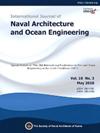在低保真无粘流模拟的基础上,基于U-net的船体绕流高保真模拟结果重建
IF 3.9
3区 工程技术
Q2 ENGINEERING, MARINE
International Journal of Naval Architecture and Ocean Engineering
Pub Date : 2025-01-01
DOI:10.1016/j.ijnaoe.2025.100676
引用次数: 0
摘要
在本研究中,训练神经网络将船体周围流动的无粘模拟数据转换为具有代表性的粘性流动模拟数据。目标是使用机器学习结合无粘流动模拟结果提供高保真的粘性流动模拟数据,这大大减少了生成时间。这种方法有可能将高保真流动模拟的速度提高100倍以上,从而实现具有许多重复情况的船体的基于仿真的设计。为了创建训练数据集,使用参数修改函数技术从六个基线船体形状生成各种船体形状。通过势流分析和计算流体力学模拟,分别获得了船体的无粘流和粘性流数据。随后通过参数化研究对神经网络结构和超参数进行优化。然后使用训练好的神经网络来预测基于非粘性流动数据和船体形状几何的粘性流动模拟数据。结果表明,该神经网络成功地预测了船体周围的压力分布和自由水面高度。值得注意的是,考虑到无粘流模拟本身缺乏这种能力,预测自由表面高程的能力是非常重要的。此外,利用神经网络的降维特征来可视化基于基线船体形状和船舶速度的潜在空间内的流量和船体形状数据的聚类情况。本文章由计算机程序翻译,如有差异,请以英文原文为准。
A U-net based reconstruction of high-fidelity simulation results for flow around a ship hull based on low-fidelity inviscid flow simulation
In this study, neural networks are trained to transform inviscid simulation data for flow around a ship hull into data representative of viscous flow simulations. The objective is to provide high-fidelity viscous flow simulation data using machine learning in conjunction with inviscid flow simulation results, which are significantly less time-consuming to generate. This approach has the potential to accelerate high-fidelity flow simulations by a factor of more than 100, enabling simulation-based design for ship hulls with numerous repetitive cases. To create the training dataset, a variety of hull forms are generated from six baseline hull forms using parametric modification function techniques. Inviscid and viscous flow data for each hull are obtained through potential flow analysis and computational fluid dynamics - simulations, respectively. The neural network structure and hyperparameters are subsequently optimized through parametric studies. The trained neural networks are then employed to predict viscous flow simulation data based on inputs comprising inviscid flow data and hull form geometry. The results demonstrate that the neural networks successfully predicted both the pressure distribution around the hull and the free surface elevation. Notably, the ability to predict the free surface elevation is significant, given that inviscid flow simulations inherently lack this capability. Additionally, the neural network's dimensionality reduction feature is utilized to visualize how the flow and hull form data were clustered within the latent space based on baseline hull forms and ship speed.
求助全文
通过发布文献求助,成功后即可免费获取论文全文。
去求助
来源期刊

International Journal of Naval Architecture and Ocean Engineering
ENGINEERING, MARINE-
CiteScore
4.90
自引率
4.50%
发文量
62
审稿时长
12 months
期刊介绍:
International Journal of Naval Architecture and Ocean Engineering provides a forum for engineers and scientists from a wide range of disciplines to present and discuss various phenomena in the utilization and preservation of ocean environment. Without being limited by the traditional categorization, it is encouraged to present advanced technology development and scientific research, as long as they are aimed for more and better human engagement with ocean environment. Topics include, but not limited to: marine hydrodynamics; structural mechanics; marine propulsion system; design methodology & practice; production technology; system dynamics & control; marine equipment technology; materials science; underwater acoustics; ocean remote sensing; and information technology related to ship and marine systems; ocean energy systems; marine environmental engineering; maritime safety engineering; polar & arctic engineering; coastal & port engineering; subsea engineering; and specialized watercraft engineering.
 求助内容:
求助内容: 应助结果提醒方式:
应助结果提醒方式:


